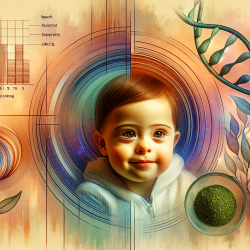Green Tea Extracts: A Potential Therapeutic Tool for Facial Development in Down Syndrome

The recent research article "Green tea extracts containing epigallocatechin-3-gallate modulate facial development in Down syndrome" provides compelling evidence on the potential benefits and risks of using green tea extracts (GTE) enriched with epigallocatechin-3-gallate (EGCG) in modulating facial development in individuals with Down syndrome (DS). As practitioners focused on improving outcomes for children, it's essential to understand how these findings can be translated into clinical practice.
Key Findings from the Research
The study conducted both experimental and observational research to evaluate the effects of GTE-EGCG on facial development:
- In a mouse model of DS, low doses of GTE-EGCG (30 mg/kg/day) improved facial skeletal morphology, whereas high doses (100 mg/kg/day) exacerbated facial dysmorphology.
- In a cross-sectional observational study of children with DS, early GTE-EGCG supplementation (during the first three years of life) was associated with reduced facial dysmorphology.
- Higher doses of GTE-EGCG disrupted normal development in both trisomic and euploid mice, indicating the importance of dose control.
Implementing Research Outcomes in Practice
To leverage these findings in clinical settings, consider the following strategies:
- Early Intervention: Encourage parents to consult with healthcare providers about the potential benefits of GTE-EGCG supplementation during the early developmental stages of their children with DS.
- Controlled Dosage: Emphasize the importance of controlled and low-dose administration of GTE-EGCG to avoid potential adverse effects. This aligns with the study's findings that low doses are beneficial while high doses can be detrimental.
- Further Research: Advocate for clinical trials to confirm the therapeutic relevance of GTE-EGCG in reducing facial dysmorphology in children with DS. Larger cohorts and controlled administration are essential to identify optimal dosage and timing.
Encouraging Further Research
The study underscores the need for additional research to understand the mechanisms by which GTE-EGCG influences facial development and to identify the ideal therapeutic window and treatment regime. Encourage your colleagues and research institutions to prioritize this area of study to provide more definitive guidance for clinical practice.
Conclusion
While GTE-EGCG shows promise in modulating facial development in DS, careful consideration of dosage and timing is crucial. Practitioners should stay informed about ongoing research and clinical trials to ensure the best outcomes for children with DS.To read the original research paper, please follow this link:
Green tea extracts containing epigallocatechin-3-gallate modulate facial development in Down syndrome.
Citation: Starbuck, J. M., Llambrich, S., Gonzàlez, R., Albaigès, J., Sarlé, A., Wouters, J., González, A., Sevillano, X., Sharpe, J., De La Torre, R., Dierssen, M., Vande Velde, G., & Martínez-Abadías, N. (2021). Green tea extracts containing epigallocatechin-3-gallate modulate facial development in Down syndrome. Scientific Reports, 11, 4715. https://doi.org/10.1038/s41598-021-83757-1










